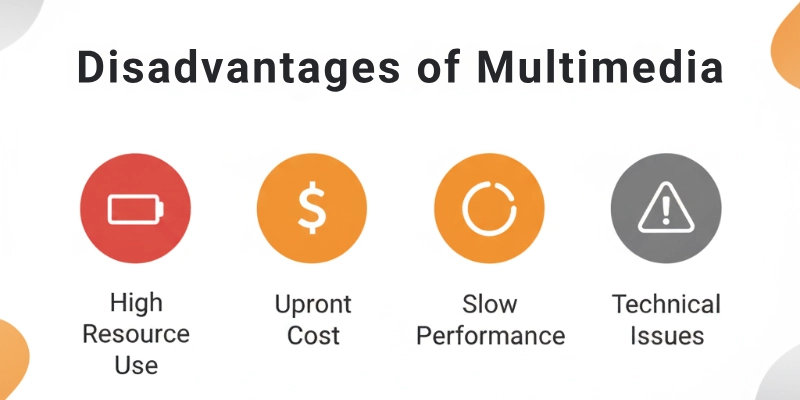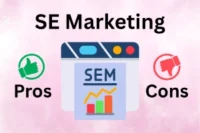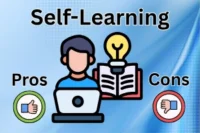15+ Pros and Cons of Multimedia
Published: 21 Aug 2025
Did you know the human brain processes visuals 60,000 times faster than text? This is one reason why multimedia, combining different media formats like images and videos, has become such a powerful tool for communication and learning.
However, multimedia also comes with its own set of challenges.
So, this article will explore both the advantages and disadvantages of multimedia, helping you understand how to best utilize its strengths while considering its drawbacks.
Advantages of Multimedia
In today’s world, multimedia has become an essential part of communication, education, and entertainment. It offers a wide range of advantages by combining different elements.

Here’s a list of the benefits multimedia provides:
- Enhanced Communication
- Increased Knowledge Retention
- Improved Learning
- Greater Accessibility
- Boosted Engagement
- Increased Creativity
- Improved Collaboration
- Simulations and Training
- Entertainment Value
- Information Dissemination
Let us cover all the pros of multimedia in detail.
1. Enhanced Communication
Multimedia makes communication clearer and more effective by combining text, images, audio, and video. Personally, I find that using visuals or videos always helps me explain things better. If you want to get your point across, adding multimedia is the way to go.
- Delivers messages in multiple formats
- Makes information easy to understand
- Helps express complex ideas more clearly
2. Increased Knowledge Retention
When information is presented with visuals and sound, people tend to remember it longer. I’ve noticed I remember concepts better after watching a video compared to just reading text. If you’re a student, try mixing your notes with multimedia for better recall.
- Improves memory retention
- Keeps learners engaged
- Makes recalling information easier
3. Improved Learning
Multimedia transforms traditional learning into interactive experiences. I believe lessons feel less boring and more practical when multimedia is included. Teachers and trainers should definitely use it to make learning fun and effective.
- Makes learning interactive and engaging
- Explains topics step by step
- Provides real-life examples through visuals
4. Greater Accessibility
Multimedia ensures that information reaches different types of learners, including those with disabilities. Personally, I think subtitles, audio guides, and visuals are a blessing for many people. If you’re sharing knowledge, adding accessibility features is a must.
- Makes content accessible for everyone
- Supports different learning styles
- Helps people with disabilities
5. Boosted Engagement
People pay more attention to multimedia than plain text. I’ve seen myself scrolling past text-heavy posts but stopping at a video. If you want to catch someone’s attention online, multimedia is your best friend.
- Captures audience interest quickly
- Keeps people engaged longer
- Increases interaction with content
6. Increased Creativity
Multimedia tools allow people to express their ideas in unique and creative ways. Personally, I feel it’s a great way to unleash imagination, whether through videos, graphics, or animations. If you love being creative, multimedia gives you endless options.
- Encourages creative expression
- Provides multiple tools for design
- Makes presentations and projects stand out
7. Improved Collaboration
Multimedia makes teamwork smoother, especially for remote groups. I’ve personally found video calls, shared documents, and visual aids super helpful in group projects. If you work in teams, using multimedia will save you time and confusion.
- Enhances teamwork through visuals and audio
- Simplifies sharing ideas
- Reduces communication barriers
8. Simulations and Training
Multimedia allows people to practice in virtual environments before facing real situations. For example, pilots train with simulators, which I find really impressive. If you’re preparing for a skill-based task, multimedia training is the safest and smartest way.
- Provides real-world practice safely
- Reduces training risks
- Helps people learn by doing
9. Entertainment Value
From movies to games, multimedia is a huge source of entertainment. Personally, I can’t imagine weekends without streaming shows or playing games. If you’re stressed, multimedia can be your go-to relaxation tool.
- Provides fun and enjoyment
- Offers interactive games, movies, and music
- Reduces stress and boredom
10. Information Dissemination
Multimedia makes it easy to share information with large audiences quickly. I feel social media posts with visuals spread like wildfire compared to plain updates. If you want your message to reach far, multimedia is the key.
- Spreads information fast
- Reaches a wider audience
- Makes content more shareable
Disadvantages of Multimedia
While multimedia offers a rich and engaging way to learn and communicate, it’s not without its drawbacks. Here’s a list of some major disadvantages of multimedia:

- Cost
- Technical Issues
- Limited Accessibility
- Dependence on Technology
- Increased Demand for Skilled Professionals
- Distraction
- Security Concerns
- Quality
Let us cover all the cons of multimedia in detail.
1. Cost
Creating high-quality multimedia can be expensive. From buying software to hiring experts, the costs can add up. Personally, I feel that for small businesses or students, this might be a big challenge. Start small with free tools before investing heavily.
- Requires costly software and hardware
- Professional services can be expensive
- Not always budget-friendly for individuals
2. Technical Issues
Multimedia relies heavily on technology, which isn’t always reliable. I’ve experienced presentations crashing at the wrong moment, and it’s frustrating. Always keep a backup to avoid embarrassment.
- Risk of software or hardware failure
- Compatibility issues with devices
- Interruptions during important tasks
3. Limited Accessibility
Not everyone has access to the latest multimedia tools. I’ve seen students struggle because they don’t have fast internet or updated devices. If you’re creating content, try to make it light and accessible for everyone.
- Requires high-speed internet
- Demands updated devices and software
- Can exclude people with limited resources
4. Dependence on Technology
Relying too much on multimedia can make people overly dependent on technology. Personally, I feel we sometimes forget simple communication because we’re too focused on flashy visuals. Balance is the key here.
- Reduces face-to-face interaction
- Creates dependency on devices
- Limits traditional communication skills
5. Increased Demand for Skilled Professionals
Good multimedia work needs skilled designers, editors, and developers. I’ve noticed that without proper skills, content can look unprofessional. If you’re interested, learning these skills is a great career investment.
- Requires trained professionals
- Not easy for beginners to master
- Can slow projects if skills are lacking
6. Distraction
Multimedia can sometimes entertain more than educate. I’ve personally gotten distracted watching animations instead of focusing on the actual content. If you’re a student, make sure you stay focused on the learning part.
- May shift focus away from main topic
- Encourages multitasking and divided attention
- Can waste time if not used properly
7. Security Concerns
Sharing multimedia online can expose you to risks like piracy or data theft. I always recommend watermarking your work or using secure platforms. Protecting your content is just as important as creating it.
- Risk of copyright violations
- Possibility of data theft or hacking
- Privacy concerns with shared media
8. Quality
Not all multimedia is high-quality, and poorly made content can hurt rather than help. I’ve seen presentations ruined by low-resolution images or bad sound. Always focus on quality over quantity.
- Poor design lowers credibility
- Low-quality visuals/audio reduce impact
- Can confuse instead of clarifying
Conclusion
In this guide, we have covered all the advantages and disadvantages of multimedia in detail. Multimedia is powerful when used for learning, communication, and business, but it also needs balance to avoid overuse or distraction. My recommendation is to use multimedia wisely, focus on its benefits and be mindful of its drawbacks. That way, you can get the best out of it. Thanks for reading, and goodbye!
FAQs
Here are some of the most frequently asked questions related to the pros and cons of multimedia:
Multimedia makes learning more interesting with images, videos, and sound. It helps students understand lessons quickly. Teachers can explain complex topics in a simple way. Overall, it improves both teaching and learning.
Multimedia can distract people if used too much. It sometimes requires expensive tools and high storage. Slow internet or weak devices also create problems. Without control, it can reduce focus and productivity.
Businesses use multimedia for ads, presentations, and training. It attracts customers through videos and graphics. Employees also learn better with multimedia training tools. This helps companies grow faster and stay competitive.
We use multimedia every day in phones, games, and social media. It entertains us with music, movies, and visuals. It also keeps us connected through video calls and online platforms. This makes life easier and more enjoyable.
Some schools cannot afford modern multimedia tools. Teachers may face issues if they lack technical skills. Students can also get distracted by videos and games. So, it needs proper balance and guidance.
Multimedia improves communication by mixing text, images, and sound. It makes messages clearer and more attractive. People remember visuals better than plain words. This makes communication faster and more effective.
Multimedia will continue to grow in education, business, and entertainment. It can improve life if used wisely. But misuse may cause distraction or over-dependence. The future impact depends on how carefully we handle it.

- Be Respectful
- Stay Relevant
- Stay Positive
- True Feedback
- Encourage Discussion
- Avoid Spamming
- No Fake News
- Don't Copy-Paste
- No Personal Attacks

- Be Respectful
- Stay Relevant
- Stay Positive
- True Feedback
- Encourage Discussion
- Avoid Spamming
- No Fake News
- Don't Copy-Paste
- No Personal Attacks





